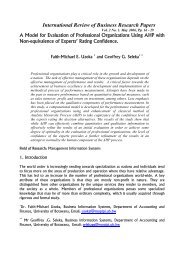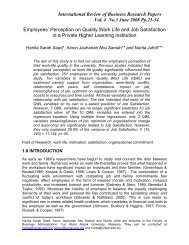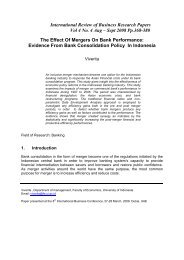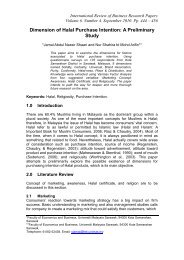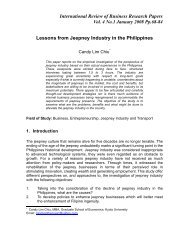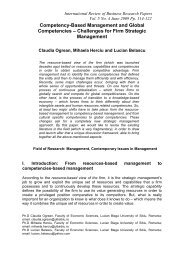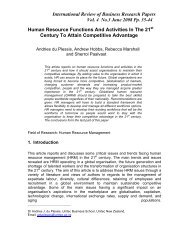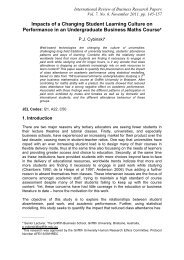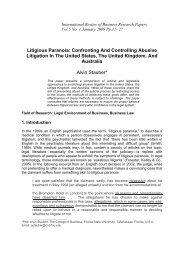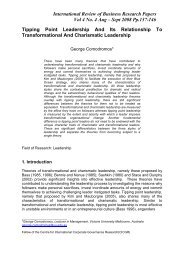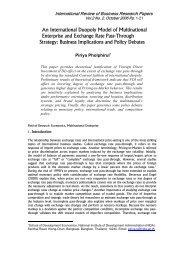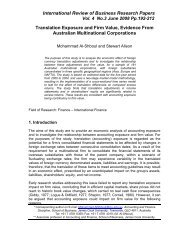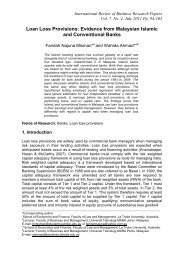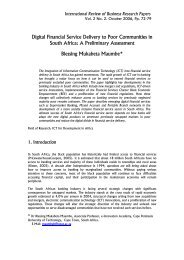Will the UCP 600 provide solutions to letter of credit transactions?
Will the UCP 600 provide solutions to letter of credit transactions?
Will the UCP 600 provide solutions to letter of credit transactions?
You also want an ePaper? Increase the reach of your titles
YUMPU automatically turns print PDFs into web optimized ePapers that Google loves.
International Review <strong>of</strong> Business Research Papers<br />
Vol.3 No.2 June 2007, Pp. 41 - 53<br />
<strong>Will</strong> <strong>the</strong> <strong>UCP</strong> <strong>600</strong> Provide Solutions <strong>to</strong> Letter <strong>of</strong> Credit<br />
Transactions?<br />
Rober<strong>to</strong> Bergami*<br />
It is generally accepted that international trade <strong>transactions</strong> carry<br />
inherently more risk than domestic trade <strong>transactions</strong>, because <strong>of</strong><br />
differences in culture, business processes, laws and regulations. It<br />
is <strong>the</strong>refore important for traders <strong>to</strong> ensure that payment is<br />
received for goods despatched and that <strong>the</strong> goods received and<br />
paid for comply with <strong>the</strong> contract <strong>of</strong> sale. One effective way <strong>of</strong><br />
managing <strong>the</strong>se risks has been for traders <strong>to</strong> rely on <strong>the</strong> <strong>letter</strong> <strong>of</strong><br />
<strong>credit</strong> as a payment method. However for exporters in particular,<br />
<strong>the</strong> <strong>letter</strong> <strong>of</strong> <strong>credit</strong> has presented difficulties in meeting <strong>the</strong><br />
compliance requirements necessary for <strong>the</strong> payment <strong>to</strong> be<br />
triggered. The current rules that govern <strong>letter</strong> <strong>of</strong> <strong>credit</strong> <strong>transactions</strong><br />
(<strong>UCP</strong> 500) have been under review for <strong>the</strong> past three years and an<br />
updated set <strong>of</strong> rules (<strong>UCP</strong> <strong>600</strong>) is expected <strong>to</strong> be introduced on 1<br />
July 2007. This paper focuses on <strong>the</strong> changes mooted for 2007<br />
and compares <strong>the</strong>se main issues with <strong>the</strong> existing rules and o<strong>the</strong>r<br />
associated guidelines and regulations governing this method <strong>of</strong><br />
payment. The conclusion is that <strong>the</strong> <strong>UCP</strong> <strong>600</strong> have not paid<br />
enough consideration <strong>to</strong> traders and service <strong>provide</strong>rs and are<br />
likely <strong>to</strong> engender an environment <strong>of</strong> uncertainty for exporters in<br />
particular.<br />
Field <strong>of</strong> Research: Economics<br />
1. Introduction<br />
This paper considers <strong>the</strong> implication <strong>to</strong> changes <strong>of</strong> <strong>letter</strong> <strong>of</strong> <strong>credit</strong> <strong>transactions</strong> and<br />
<strong>the</strong> sharing <strong>of</strong> risk. Firstly <strong>the</strong> paper <strong>provide</strong>s some background <strong>to</strong> <strong>letter</strong>s <strong>of</strong> <strong>credit</strong>,<br />
<strong>the</strong>n comments on existing literature and models, and subsequently an analysis <strong>of</strong><br />
<strong>the</strong> most important changes <strong>to</strong> <strong>the</strong> existing rules, before reaching a conclusion.<br />
Letters <strong>of</strong> <strong>credit</strong> have been described “as <strong>the</strong> lifeblood <strong>of</strong> international commerce”<br />
(D'Arcy, Murray & Cleave 2000, p. 166). Recent estimates place <strong>letter</strong> <strong>of</strong> <strong>credit</strong><br />
<strong>transactions</strong> in excess <strong>of</strong> USD 1 trillion per annum (Klein 2006, p. 1), making this<br />
method <strong>of</strong> payment significant indeed. The <strong>letter</strong> <strong>of</strong> <strong>credit</strong> transaction is governed by<br />
a specific set <strong>of</strong> rules: <strong>the</strong> Uniform Cus<strong>to</strong>ms and Practice for Documentary Credits<br />
(<strong>UCP</strong> 500), issued by <strong>the</strong> International Chamber <strong>of</strong> Commerce (ICC) in 1993. These<br />
rules allow for two distinct types <strong>of</strong> <strong>letter</strong>s <strong>of</strong> <strong>credit</strong>: revocable and irrevocable.<br />
________________________________<br />
*School <strong>of</strong> Applied Economics, Institute for Logistics and Supply Chain Management, Vic<strong>to</strong>ria<br />
University, Melbourne, Australia<br />
41
Bergami<br />
Revocable <strong>letter</strong>s <strong>of</strong> <strong>credit</strong> allow <strong>the</strong> document and <strong>the</strong> clauses <strong>to</strong> be changed<br />
without <strong>the</strong> agreement <strong>of</strong> <strong>the</strong> exporter, whereas irrevocable <strong>letter</strong>s <strong>of</strong> <strong>credit</strong>, once<br />
issued, require <strong>the</strong> agreement <strong>of</strong> <strong>the</strong> exporter before any changes can be<br />
incorporated. The irrevocable <strong>credit</strong>, <strong>the</strong>refore <strong>provide</strong>s a higher degree <strong>of</strong> payment<br />
security for <strong>the</strong> exporter. Under <strong>the</strong> <strong>UCP</strong> 500 all <strong>letter</strong>s <strong>of</strong> <strong>credit</strong> are irrevocable<br />
unless <strong>the</strong> parties explicitly wish o<strong>the</strong>rwise. As revocable <strong>letter</strong>s <strong>of</strong> <strong>credit</strong> are hardly<br />
used in modern commerce, <strong>the</strong>y are not considered in <strong>the</strong> context <strong>of</strong> this paper.<br />
The <strong>letter</strong> <strong>of</strong> <strong>credit</strong> is well suited <strong>to</strong> large transactional values and in areas <strong>of</strong> higher<br />
risk, as this payment instrument allows <strong>the</strong> exporter <strong>to</strong> substitute <strong>the</strong> <strong>credit</strong> standing<br />
<strong>of</strong> <strong>the</strong> buyer with that <strong>of</strong> his bank, or even ano<strong>the</strong>r bank outside <strong>the</strong> buyer‟s country.<br />
The <strong>letter</strong> <strong>of</strong> <strong>credit</strong> is a conditional guarantee <strong>of</strong> payment given by <strong>the</strong> issuing bank<br />
(who establishes <strong>the</strong> <strong>credit</strong> - typically <strong>the</strong> importer‟s bank) <strong>to</strong> <strong>the</strong> beneficiary (<strong>the</strong><br />
recipient <strong>of</strong> <strong>the</strong> <strong>credit</strong> - <strong>the</strong> exporter). The condition is that <strong>the</strong> beneficiary must meet<br />
all <strong>of</strong> <strong>the</strong> issuing bank‟s requirements, <strong>the</strong>reby triggering <strong>the</strong> payment.<br />
The whole transaction, ins<strong>of</strong>ar as <strong>the</strong> payment mechanism is concerned, is based<br />
purely on documentation that banks check for compliance against <strong>the</strong> <strong>letter</strong> <strong>of</strong> <strong>credit</strong>,<br />
and each o<strong>the</strong>r document for consistency. The documents are deemed <strong>to</strong> represent<br />
<strong>the</strong> goods. Documentary compliance for <strong>the</strong> exporter, <strong>the</strong>refore, is imperative in<br />
claiming an unencumbered payment. Yet, according <strong>to</strong> <strong>the</strong> ICC, documentary noncompliance<br />
is as high as seventy per cent (ICC Thailand 2002). In <strong>the</strong> majority <strong>of</strong><br />
cases exporters run <strong>the</strong> risk <strong>of</strong> not being paid because <strong>the</strong>y fail <strong>to</strong> satisfy <strong>the</strong> banks‟<br />
requirements for specific data content on documents. Exporters choose <strong>to</strong> deal<br />
through <strong>letter</strong>s <strong>of</strong> <strong>credit</strong> <strong>to</strong> ensure payment, yet lose that benefit by <strong>the</strong> provision on<br />
non-compliant documents.<br />
One <strong>of</strong> <strong>the</strong> reasons for documentary non-compliance has been a somewhat<br />
subjective and interpretative approach <strong>to</strong> <strong>letter</strong> <strong>of</strong> <strong>credit</strong> compliance that, in <strong>the</strong> first<br />
instance, is unilaterally decided by <strong>the</strong> banks. This issue comes at a cost <strong>to</strong><br />
exporters. In <strong>the</strong> UK alone, it is estimated that <strong>the</strong> cost <strong>of</strong> documentary discrepancies<br />
is in <strong>the</strong> order <strong>of</strong> £ 113 million per annum (SITPRO 2003, p. 2). The ICC has made a<br />
number <strong>of</strong> attempts <strong>to</strong> clarify this area, but none have been successful, and a new<br />
set <strong>of</strong> rules - <strong>UCP</strong> <strong>600</strong> (International Chamber <strong>of</strong> Commerce 2006) - is due <strong>to</strong> be<br />
invoked on 1 July 2007. This paper considers whe<strong>the</strong>r <strong>the</strong> <strong>UCP</strong> <strong>600</strong> will invoke<br />
changes that will enable a higher proportion <strong>of</strong> documentary compliance <strong>to</strong> be<br />
achieved by exporters. This is an important consideration, because <strong>of</strong> <strong>the</strong> potential<br />
financial losses exporters face through non-compliant documents. To continue <strong>to</strong><br />
play a pivotal role in international trade finance, <strong>the</strong> <strong>letter</strong> <strong>of</strong> <strong>credit</strong> rules must <strong>provide</strong><br />
certainty and stability on a transaction-by-transaction basis, with clear and<br />
predictable outcomes. In this context it is <strong>the</strong>refore important <strong>to</strong> examine <strong>the</strong> new<br />
rules in detail in order <strong>to</strong> determine whe<strong>the</strong>r <strong>the</strong>se meet <strong>the</strong> expected outcomes <strong>of</strong> all<br />
stakeholders involved in <strong>the</strong> transaction.<br />
2. Literature Review<br />
There is a high volume <strong>of</strong> literature in <strong>the</strong> field <strong>of</strong> risk management with different foci.<br />
The majority <strong>of</strong> <strong>the</strong>se publications focus on financial risk management from different<br />
perspectives, such as banking, (Bessis, 1998) <strong>credit</strong> or debt management, (Clarke,<br />
1997; Finnerty & Emery, 2001), marketing, (Keegan, 1997), decision making, (Bell,<br />
Raiffa, & Tversky, 1988) legal (Mugasha, 2003) and so on.<br />
These publications bear little relevance <strong>to</strong> <strong>the</strong> focus <strong>of</strong> this paper.<br />
42
Bergami<br />
The world‟s first standard on risk management was published Standards<br />
Australia/New Zealand in 1999 (Joint Technical Committee OB/& - Risk<br />
Management). The model developed by <strong>the</strong> standard is generic in nature and is<br />
independent <strong>of</strong> industry or economic sec<strong>to</strong>rs. This model concentrates on <strong>the</strong><br />
management aspects <strong>of</strong> any risk, but does not appear <strong>to</strong> be closely linked <strong>to</strong> <strong>the</strong><br />
operations <strong>of</strong> an organisation and <strong>the</strong>refore has limited value for this paper.<br />
There is an abundance <strong>of</strong> literature on L/C <strong>transactions</strong>, (Venedikian & Warfield,<br />
2000), (Burnett, 2004), (Madura, 2003), but this is only descriptive and general in<br />
nature, lacking analysis. Journal articles in various disciplines concentrate on <strong>the</strong><br />
need <strong>of</strong> using L/C as a financing <strong>to</strong>ol (Luxon, 1998; Karpen, 1995; Schlesinger,<br />
2003), and <strong>the</strong> different types that <strong>of</strong> L/C that have been devised (Weissman, 1996).<br />
The legal status <strong>of</strong> L/C varies from country <strong>to</strong> country and journals and books have<br />
covered this aspect <strong>to</strong> varying degrees. (Creed, 2001; Mugasha, 2003) The ICC has<br />
even published a book comparing legislation on L/C in 35 countries (Schutze &<br />
Fontane, 2001). All <strong>of</strong> <strong>the</strong> current literature does not consider <strong>the</strong> new <strong>UCP</strong> <strong>600</strong>, and<br />
its usefulness is <strong>the</strong>refore generally limited.<br />
The issue <strong>of</strong> documentary discrepancies has received attention in journals, however<br />
<strong>the</strong> focus has been general in nature with summarised steps attempting <strong>to</strong> <strong>provide</strong><br />
ideas for <strong>solutions</strong> through simple checklists. (Baker, 2000; Metha, 1999). Whilst<br />
descriptive literature is abundant, <strong>the</strong>re appears <strong>to</strong> be a world-wide dearth <strong>of</strong><br />
<strong>the</strong>oretical literature in documentary discrepancies research.<br />
The most applicable study conducted in <strong>the</strong> area <strong>of</strong> <strong>letter</strong>s <strong>of</strong> <strong>credit</strong> appears <strong>to</strong> be<br />
that undertaken in <strong>the</strong> US by Mann (2000, pp. 2494 - 2547). Mann confirms <strong>the</strong> high<br />
rate <strong>of</strong> discrepancies that occur in L/C <strong>transactions</strong>. As part <strong>of</strong> his study Mann claims<br />
that <strong>the</strong> high discrepancy rate is probably <strong>of</strong> little financial consequence in a market<br />
where buyer demand is buoyant and <strong>the</strong> goods are highly sought after by <strong>the</strong><br />
overseas buyer. There were three responses <strong>to</strong> Mann‟s paper. One concludes his<br />
article by stating that “Mann‟s data and his analysis both make it possible and<br />
demand a number <strong>of</strong> promising lines <strong>of</strong> future research” (Corre 2000, p. 2553).<br />
Ano<strong>the</strong>r comments that some <strong>of</strong> Mann‟s explanations are “creative, interesting and,<br />
as far as I now, original” (Katz 2000, p. 2555). The third disputes <strong>the</strong> findings on <strong>the</strong><br />
basis that Mann‟s study ignored some <strong>of</strong> <strong>the</strong> parties involved in a L/C transaction<br />
stating that “reliable empiricism demand that <strong>the</strong> relevant enquiries be made <strong>of</strong> all<br />
parties <strong>to</strong> <strong>the</strong> transaction” (Gillette 2000, p. 2547). The responses <strong>to</strong> Mann‟s work<br />
include praise for <strong>the</strong> research conducted and describe it as a “valuable<br />
contribution”, (Katz, 2000, p. 2554) and “groundbreaking” (Corre, 2000, p. 2553).<br />
However, o<strong>the</strong>r comments also point out that “Mann‟s information-verification <strong>the</strong>ory<br />
<strong>of</strong> <strong>letter</strong>s <strong>of</strong> <strong>credit</strong> is instructive, original, and important, but incomplete” (Katz, 2000,<br />
p. 2572). These comments suggest that notwithstanding Mann‟s work, <strong>the</strong>re is an<br />
opportunity for more research <strong>to</strong> deepen <strong>the</strong> understanding <strong>of</strong> <strong>the</strong> seller-bank-buyer<br />
inter-relationships that are set up under a L/C transaction. Mann‟s study is also<br />
limited in value, as this was done under <strong>the</strong> current <strong>UCP</strong> 500 not <strong>the</strong> new <strong>UCP</strong> <strong>600</strong>,<br />
so <strong>the</strong> findings could at best be used for comparative purposes. As <strong>the</strong> <strong>UCP</strong> <strong>600</strong> are<br />
not expected <strong>to</strong> take effect until 1 July 2007, any comparative study would need <strong>to</strong><br />
wait until some his<strong>to</strong>ry with hew rules has developed, probably beyond 2008.<br />
A business risk framework, such as <strong>the</strong> one proposed by McNamee (2000) i , shown<br />
in Figure 1 below is a useful model in considering <strong>the</strong> major elements <strong>of</strong> risk.<br />
43
Bergami<br />
Figure 1: Business Risk Model (McNamee 2000)<br />
The risks most relevant <strong>to</strong> this <strong>the</strong> focus <strong>of</strong> this paper are <strong>the</strong> behavioural and<br />
process risks as <strong>the</strong>y give rise <strong>to</strong> a number <strong>of</strong> elements that are closely linked <strong>to</strong> <strong>the</strong><br />
problems <strong>of</strong> <strong>letter</strong> <strong>of</strong> <strong>credit</strong> <strong>transactions</strong>, viz: errors, omissions, delays, frauds,<br />
productivity losses and a dysfunctional work place. All <strong>of</strong> <strong>the</strong>se elements ei<strong>the</strong>r form<br />
part <strong>of</strong> or contribute <strong>to</strong> documentary discrepancies. Whilst <strong>the</strong> McNamee model may<br />
prove valuable as a basis for considering <strong>the</strong> firm‟s risk, particularly as it applies <strong>to</strong><br />
external risk, this model has limited application in <strong>the</strong> context <strong>of</strong> this paper, because<br />
<strong>the</strong> new <strong>UCP</strong> <strong>600</strong> rules are yet <strong>to</strong> be implemented, and <strong>the</strong>re is current uncertainty<br />
on possible results from <strong>the</strong> implementation <strong>of</strong> aspects <strong>of</strong> <strong>the</strong> new rules, as<br />
discussed later in <strong>the</strong> paper. The MacNamee model <strong>the</strong>refore has not been included<br />
in <strong>the</strong> discussion <strong>of</strong> <strong>the</strong> prposed changes outlined in this paper.<br />
3. The Letter <strong>of</strong> Credit Contracts and Cycle<br />
The <strong>letter</strong> <strong>of</strong> <strong>credit</strong> transaction is complex, as its issue gives rise <strong>to</strong> a number <strong>of</strong><br />
contracts that operate independently <strong>of</strong> <strong>the</strong> sales contract. These contracts are<br />
shown at Figure 2.<br />
44
Bergami<br />
EXPORTER<br />
(Beneficiary)<br />
1. Sales / Purchase Contract<br />
IMPORTER<br />
(Applicant)<br />
5. Contract<br />
between <strong>the</strong><br />
Beneficiary<br />
and<br />
Correspondent/<br />
Advising Bank<br />
3. Contract<br />
between<br />
Issuing Bank<br />
and <strong>the</strong><br />
Beneficiary<br />
2. Contract<br />
between<br />
Applicant<br />
and<br />
Issuing<br />
Bank<br />
CORRESPONDENT/<br />
ADVISING BANK<br />
(Exporter’s Bank)<br />
4. Contract between Issuing Bank<br />
and <strong>the</strong> Correspondent /<br />
Advising Bank<br />
ISSUING BANK<br />
(Importer’s Bank)<br />
Figure 2: Typical contracts arising from a <strong>letter</strong> <strong>of</strong> <strong>credit</strong> transaction (Bergami 2004,<br />
p. 23)<br />
The sales contract is <strong>the</strong> legally binding agreement in which <strong>the</strong> exporter and<br />
importer will agree <strong>to</strong> utilise <strong>the</strong> <strong>letter</strong> <strong>of</strong> <strong>credit</strong> as <strong>the</strong> method <strong>of</strong> payment (contract<br />
number 1). The importer needs <strong>to</strong> apply <strong>to</strong> his bank <strong>to</strong> have <strong>the</strong> <strong>letter</strong> <strong>of</strong> <strong>credit</strong> issued<br />
(contract number 2). This application is subject <strong>to</strong> <strong>the</strong> bank‟s usual commercial risk<br />
analysis and due diligence and <strong>the</strong>refore it may be rejected where <strong>the</strong> <strong>credit</strong> risk <strong>of</strong><br />
<strong>the</strong> buyer is unacceptable <strong>to</strong> <strong>the</strong> bank. If <strong>the</strong> decision is taken by <strong>the</strong> bank <strong>to</strong> issue<br />
this payment instrument, <strong>the</strong>n an undertaking <strong>to</strong> pay, subject <strong>to</strong> certain conditions is<br />
created (contract number 3). As <strong>letter</strong>s <strong>of</strong> <strong>credit</strong> operate through <strong>the</strong> banking system,<br />
<strong>the</strong> issuing bank engages <strong>the</strong> services <strong>of</strong> <strong>the</strong> exporter‟s bank <strong>to</strong> advise <strong>the</strong> <strong>credit</strong><br />
(contract number 4). The advising bank in turn engages with <strong>the</strong> exporter in advising<br />
<strong>the</strong> <strong>letter</strong> <strong>of</strong> <strong>credit</strong>, after au<strong>the</strong>nticating same (contract number 5). The sequence <strong>of</strong><br />
events that typically apply <strong>to</strong> a deferred payment <strong>letter</strong> <strong>of</strong> <strong>credit</strong> transaction is shown<br />
at Figure 3.<br />
The critical area for <strong>the</strong> exporter endeavouring <strong>to</strong> achieve documentary compliance,<br />
and <strong>the</strong>refore payment, is at step 6. By this stage <strong>the</strong> exporter, having received <strong>the</strong><br />
<strong>letter</strong> <strong>of</strong> <strong>credit</strong> (step 4) and checked it for consistency against <strong>the</strong> contract <strong>of</strong> sale,<br />
had dispatched <strong>the</strong> goods (step 5) and lodged same with <strong>the</strong> bank (step 6), for<br />
examination and acceptance. The payment will be received by <strong>the</strong> exporter <strong>provide</strong>d<br />
<strong>the</strong> documentary compliance is achieved <strong>to</strong> <strong>the</strong> satisfaction <strong>of</strong> <strong>the</strong> bank.<br />
45
Bergami<br />
EXPORTER<br />
CONTRACT OF SALE<br />
1 1<br />
IMPORTER<br />
GOODS<br />
5<br />
11<br />
4<br />
9<br />
2<br />
6<br />
8<br />
3<br />
EXPORTER'S<br />
BANK<br />
10<br />
7<br />
IMPORTER'S<br />
BANK<br />
Legend:<br />
1. Contract <strong>of</strong> sale between <strong>the</strong> parties – L/C is <strong>the</strong> method <strong>of</strong> payment chosen<br />
2. Importer lodges L/C application with issuing bank<br />
3. Issuing bank issues L/C <strong>to</strong> advising bank<br />
4. L/C advised <strong>to</strong> exporter<br />
5. Goods despatched<br />
6. Required paper based documents lodged by exporter <strong>to</strong> <strong>the</strong> bank<br />
(al<strong>to</strong>ge<strong>the</strong>r in one presentation)<br />
7. Documents sent <strong>to</strong> issuing bank for acceptance<br />
8. Documents released <strong>to</strong> importer<br />
9. Funds transferred from importer on due date<br />
10. Funds transferred from issuing bank<br />
11. Funds transferred <strong>to</strong> exporter<br />
Notwithstanding that <strong>the</strong> <strong>UCP</strong> 500 have been in operation since 1994, <strong>the</strong>re have<br />
Figure 3: Typical <strong>letter</strong> <strong>of</strong> <strong>credit</strong> cycle - deferred payment option (Bergami 2005)<br />
been a number <strong>of</strong> ongoing problems associated with <strong>the</strong> interpretation <strong>of</strong> some <strong>of</strong> <strong>the</strong><br />
rules, resulting in <strong>the</strong> ICC publishing four position papers <strong>to</strong> clarify <strong>the</strong> main issues<br />
(Collyer 2006). In particular, seven articles (numbers 9, 13, 14, 21, 23, 37 and 48)<br />
have been <strong>the</strong> subject <strong>of</strong> “more than 58% <strong>of</strong> all <strong>the</strong> ICC Opinions” (Department <strong>of</strong><br />
Policy and Business Practices 2003, p. 2). A specially convened ICC Taskforce was<br />
charged with <strong>the</strong> review <strong>of</strong> <strong>the</strong>se articles, while a smaller Working Group was<br />
charged with <strong>the</strong> review <strong>of</strong> <strong>the</strong> remaining forty-two articles. Of particular importance<br />
<strong>to</strong> exporters and transport document <strong>provide</strong>rs are <strong>the</strong> following three <strong>UCP</strong> 500<br />
articles:<br />
13 - Standards for Examination <strong>of</strong> Documents;<br />
14 - Discrepant Document and Notice;<br />
37 - Commercial Invoices.<br />
46
Bergami<br />
The <strong>UCP</strong> <strong>600</strong> proposed response <strong>to</strong> <strong>the</strong>se articles is considered in next section <strong>of</strong><br />
this paper in <strong>the</strong> context <strong>of</strong> <strong>the</strong> implications for exporters in future <strong>letter</strong> <strong>of</strong> <strong>credit</strong><br />
<strong>transactions</strong>.<br />
4. The Proposed <strong>UCP</strong> <strong>600</strong> and its “Solutions”<br />
The <strong>UCP</strong> 500 is comprised <strong>of</strong> 49 articles, whereas <strong>the</strong> <strong>UCP</strong> <strong>600</strong> (Drafting Group -<br />
Commission on Banking Technique and Practices 2006) only has 39 articles. The<br />
reduction in <strong>the</strong> number <strong>of</strong> articles does not translate <strong>to</strong> an easier interpretation <strong>of</strong><br />
<strong>the</strong> <strong>UCP</strong> <strong>600</strong>. Various experts and industry representative bodies are confused and<br />
in disagreement with some <strong>of</strong> <strong>the</strong> proposed provisions <strong>of</strong> <strong>the</strong> <strong>UCP</strong> <strong>600</strong>. This is<br />
evidenced throughout <strong>the</strong> executive summary <strong>of</strong> <strong>the</strong> May meeting <strong>of</strong> <strong>the</strong> Commission<br />
on Banking Technique and Practice (Department <strong>of</strong> Policy and Business Practices<br />
2006), where comments from participants about <strong>the</strong> proposed rules amounted <strong>to</strong><br />
more than 150 pages (Kreitman 2006a, p. 1), and recent public media statements by<br />
industry bodies (International Federation <strong>of</strong> Freight Forwarders Associations 2006).<br />
The concern with this situation is that, despite <strong>the</strong> lack <strong>of</strong> unity <strong>of</strong> stakeholders<br />
involved in <strong>letter</strong> <strong>of</strong> <strong>credit</strong> <strong>transactions</strong>, <strong>the</strong> draft <strong>UCP</strong> <strong>600</strong> will be subject <strong>to</strong> “a „yes‟ or<br />
„no‟ vote at <strong>the</strong> ICC Banking Commission meeting <strong>to</strong> be held on Oc<strong>to</strong>ber 24/25, 2006<br />
solely based on <strong>the</strong> content <strong>of</strong> that draft” (Collyer 2006). If <strong>the</strong> majority vote is<br />
positive, <strong>the</strong>n <strong>the</strong> <strong>UCP</strong> <strong>600</strong> will take effect, most likely, from 1 July, 2007. Whilst <strong>the</strong><br />
time frame for educational dissemination <strong>of</strong> <strong>the</strong> new rules may be acceptable, it is<br />
<strong>the</strong> content <strong>of</strong> <strong>the</strong> new articles that continues <strong>to</strong> cause concern for exporters,<br />
transport <strong>provide</strong>rs and insurers. The three articles identified earlier are considered<br />
below.<br />
(i) Article 13: <strong>UCP</strong> 500 (Article 14: <strong>UCP</strong> <strong>600</strong>)<br />
From <strong>the</strong> exporter‟s point <strong>of</strong> view one <strong>of</strong> <strong>the</strong> most crucial steps is <strong>the</strong> presentation <strong>of</strong><br />
<strong>the</strong> documents <strong>to</strong> <strong>the</strong> counters <strong>of</strong> <strong>the</strong> receiving bank under a <strong>letter</strong> <strong>of</strong> <strong>credit</strong><br />
transaction (step 6 in Figure 3), as this triggers <strong>the</strong> documentary compliance check<br />
cycle. It is at this stage that Article 13, one <strong>of</strong> <strong>the</strong> most important articles <strong>of</strong> <strong>the</strong> <strong>UCP</strong><br />
500, takes effect. Article 13 requires <strong>the</strong> bank <strong>to</strong> check <strong>the</strong> documents received by<br />
<strong>the</strong> exporter for compliance against <strong>the</strong> <strong>letter</strong> <strong>of</strong> <strong>credit</strong> and such compliance “shall be<br />
determined by international standard banking practice as reflected in <strong>the</strong>se articles”<br />
(International Chamber <strong>of</strong> Commerce 1993, p. 5). The problem with <strong>UCP</strong> 500 Article<br />
13 is that, at <strong>the</strong> time <strong>the</strong>se rules became operational, it made a reference <strong>to</strong> a nonexistent<br />
standard. Indeed it was not until 2003 that <strong>the</strong> ICC published <strong>the</strong><br />
International Standard Banking Practice (ISBP), ten years after <strong>the</strong> international<br />
banking system was supposed <strong>to</strong> use such standards for accepting documentation<br />
upon which <strong>to</strong> effect payments. To make matters even more ludicrous, <strong>the</strong> ICC<br />
decided <strong>to</strong> make <strong>the</strong> adoption <strong>of</strong> <strong>the</strong> ISBP voluntary and in an amazing display <strong>of</strong><br />
“vacuum” thinking, <strong>the</strong> ISBP were declared <strong>to</strong> be merely “guidelines”. Although <strong>the</strong><br />
ISBP were devised <strong>to</strong> <strong>provide</strong> a standard for bankers <strong>to</strong> operate with and <strong>provide</strong> a<br />
degree <strong>of</strong> predictability in documentary compliance, <strong>the</strong> voluntary adoption clause<br />
meant that exporters were now dealing in a more uncertain world, one where two<br />
banks may have differing opinions about documentary compliance depending on<br />
whe<strong>the</strong>r <strong>the</strong>y followed <strong>the</strong> ISBP or not. Even though <strong>the</strong> ISBP have no “power” <strong>of</strong><br />
<strong>the</strong>ir own, <strong>the</strong>y do influence <strong>the</strong> interpretation <strong>of</strong> <strong>the</strong> <strong>UCP</strong> 500, however rejection <strong>of</strong><br />
47
Bergami<br />
documents must be based on breaches <strong>of</strong> <strong>the</strong> <strong>UCP</strong> 500 articles, without reference <strong>to</strong><br />
ISBP. In summary <strong>the</strong> ICC waits ten years <strong>to</strong> issue a standard and <strong>the</strong>n makes this<br />
voluntary and gives it no authoritative power. This is hardly what could be considered<br />
<strong>to</strong> be an approach designed <strong>to</strong> instil confidence in traders. The <strong>UCP</strong> <strong>600</strong> Article 14<br />
(replacing <strong>UCP</strong> 500 Article 13) is <strong>the</strong> future “solution” proposed by <strong>the</strong> ICC, but it is<br />
not without problems for exporters:<br />
The requirements for banks <strong>to</strong> follow international standard banking practice<br />
remains in this article but, significantly, this requirement does not appear <strong>to</strong><br />
refer <strong>to</strong> <strong>the</strong> ISBP necessarily (Kreitman 2006b, p. 2). It is <strong>the</strong>refore unclear as<br />
<strong>to</strong> which international banking practices ought <strong>to</strong> apply, certainly not ISBP, as<br />
<strong>the</strong>se guidelines are linked <strong>to</strong> <strong>the</strong> <strong>UCP</strong> 500 articles. There has been no<br />
statement or attempt by <strong>the</strong> ICC, <strong>to</strong> date, <strong>to</strong> indicate whe<strong>the</strong>r, or when, <strong>the</strong><br />
ISBP may be revised in line with <strong>the</strong> <strong>UCP</strong> <strong>600</strong>. The lack <strong>of</strong> such direction may<br />
result in ano<strong>the</strong>r phase <strong>of</strong> uncertainty for exporters, similar <strong>to</strong> <strong>the</strong> period <strong>of</strong><br />
1993 <strong>to</strong> 2003, where international standard banking practices were expected,<br />
but not in existence.<br />
The cause <strong>of</strong> many discrepancies has not been alleviated as <strong>the</strong> requirement<br />
for consistency <strong>of</strong> data among documents is retained, regardless <strong>of</strong> whe<strong>the</strong>r<br />
<strong>the</strong>se data are actually called for in <strong>the</strong> <strong>credit</strong> or not. The doctrine <strong>of</strong><br />
materiality does not appear <strong>to</strong> have been considered in <strong>the</strong> <strong>UCP</strong> <strong>600</strong>, ra<strong>the</strong>r<br />
<strong>the</strong> doctrine <strong>of</strong> strict compliance is still being followed. As an example, a<br />
spelling error between two documents, even in a field not specified in <strong>the</strong><br />
<strong>letter</strong> <strong>of</strong> <strong>credit</strong>, still enables a bank <strong>the</strong> opportunity <strong>to</strong> reject <strong>the</strong> documents<br />
and jeopardise <strong>the</strong> payment, regardless <strong>of</strong> how minor or irrelevant this<br />
spelling error may be. The practice <strong>of</strong> “inventing discrepancies” is still<br />
commonplace with banks “using technicalities <strong>to</strong> dishonour documentary<br />
<strong>credit</strong>s - for example, a misspelling <strong>of</strong> <strong>the</strong> word „suit‟" (International Chamber<br />
<strong>of</strong> Commerce 2004). Indeed this is a common occurrence in some parts <strong>of</strong> <strong>the</strong><br />
world as evidenced by <strong>the</strong> representations made at an ICC meeting in 2005,<br />
where <strong>the</strong>re were “a number <strong>of</strong> very frank admissions from some banks in<br />
Asia that re-examination <strong>of</strong> documents represented a very significant source<br />
<strong>of</strong> income” (Kreitman 2005, p. 2). Such practices also cause longer settlement<br />
periods, as no funds are transferred until <strong>the</strong> documents are re-examined and<br />
finally accepted. This situation negatively impacts on exporters‟ cash flows<br />
and increases <strong>the</strong> risk <strong>of</strong> payment default.<br />
The expression “on <strong>the</strong>ir face” in relation <strong>to</strong> <strong>the</strong> checking <strong>of</strong> documents for<br />
compliance has been retained, despite <strong>the</strong> fact that <strong>the</strong> <strong>UCP</strong> <strong>600</strong> “Consulting<br />
Group <strong>to</strong>ok <strong>the</strong> position (in an 18-5 vote) that <strong>the</strong> way <strong>the</strong> <strong>UCP</strong> was worded<br />
now „on its face‟ was superfluous and should be removed” (Department <strong>of</strong><br />
Policy and Business Practices 2006, p. 6). This expression has created<br />
concern because <strong>of</strong> its unclear meaning, not only in English, but also in o<strong>the</strong>r<br />
languages. As an example <strong>the</strong>re is no such expression in <strong>the</strong> French<br />
language (International Chamber <strong>of</strong> Commerce 2005). It appears that <strong>the</strong> ICC<br />
<strong>to</strong> date has ignored calls for changes <strong>to</strong> this article, despite obvious and<br />
significant difficulties in implementing its requirements.<br />
(ii) Article 14: <strong>UCP</strong> 500 (Article 16: <strong>UCP</strong> <strong>600</strong>)<br />
Article 14 <strong>of</strong> <strong>the</strong> <strong>UCP</strong> 500 has been replaced by Article 16 <strong>of</strong> <strong>the</strong> <strong>UCP</strong> <strong>600</strong>. This<br />
article prescribes actions that banks must follow when confronted with discrepant<br />
48
Bergami<br />
documents. Under <strong>the</strong> <strong>UCP</strong> 500 regime <strong>the</strong> issuing bank may, in its sole judgement,<br />
approach <strong>the</strong> importer for a written waiver, seeking acceptance <strong>of</strong> <strong>the</strong> documents.<br />
Even where <strong>the</strong> waiver is given, though, <strong>the</strong> issuing bank has no obligation <strong>to</strong> accept<br />
same, because <strong>of</strong> <strong>the</strong> contractual considerations that exist in <strong>the</strong> <strong>letter</strong> <strong>of</strong> <strong>credit</strong><br />
mechanism, as shown in Figure 1, contracts 2 and 3.<br />
The <strong>UCP</strong> <strong>600</strong> <strong>provide</strong> a better opportunity for <strong>the</strong> exporter in situations where<br />
discrepant documents exist. Although <strong>the</strong> prescribed action pathway remains, <strong>the</strong>re<br />
is now an additional option for <strong>the</strong> bank <strong>to</strong> handle <strong>the</strong> documents in accordance with<br />
<strong>the</strong> exporter‟s prior instructions. It would be possible for <strong>the</strong> exporter <strong>to</strong> request<br />
consultation from <strong>the</strong> bank, prior <strong>to</strong> seeking a written waiver from <strong>the</strong> buyer <strong>to</strong> accept<br />
<strong>the</strong> discrepant documents. This may prove useful in a situation where <strong>the</strong> market<br />
price <strong>of</strong> <strong>the</strong> goods has increased with <strong>the</strong> exporter now having an opportunity <strong>to</strong> gain<br />
additional revenue (Kreitman 2005, p. 2).<br />
(iii) Article 37 <strong>UCP</strong> 500 (Article 14: <strong>UCP</strong> <strong>600</strong>)<br />
Article 37 <strong>of</strong> <strong>the</strong> <strong>UCP</strong> 500 has been incorporated in<strong>to</strong> Article 14 <strong>of</strong> <strong>the</strong> <strong>UCP</strong> <strong>600</strong>. The<br />
strict compliance requirement expected on <strong>the</strong> product description on <strong>the</strong><br />
commercial invoice under <strong>the</strong> <strong>UCP</strong> 500 appears <strong>to</strong> have been diluted. The UP 500<br />
Article 37(c) states” The description <strong>of</strong> <strong>the</strong> goods in <strong>the</strong> commercial invoice must<br />
correspond with <strong>the</strong> description in <strong>the</strong> <strong>credit</strong>”. In part this statement was responsible<br />
for <strong>the</strong> development <strong>of</strong> <strong>the</strong> practice <strong>of</strong> “inventing discrepancies” referred <strong>to</strong> earlier.<br />
The <strong>UCP</strong> <strong>600</strong> no longer bears such a prescriptive approach on <strong>the</strong> description <strong>of</strong> <strong>the</strong><br />
goods on commercial invoices, <strong>the</strong>reby allowing document checkers a greater<br />
degree <strong>of</strong> flexibility that should result in fewer documentary discrepancies and<br />
rejections.<br />
5. O<strong>the</strong>r Major Areas <strong>of</strong> Concern<br />
As late as 23 September 2006, FIATA (International Federation <strong>of</strong> Freight<br />
Forwarders Associations), <strong>the</strong> body representing <strong>the</strong> freight forwarding community,<br />
expressed concern about <strong>the</strong> <strong>UCP</strong> <strong>600</strong> transport articles (International Federation <strong>of</strong><br />
Freight Forwarders Associations 2006), as <strong>the</strong>se rules would no longer recognise<br />
FIATA transport documents. On a broader basis <strong>the</strong> concept <strong>of</strong> a “document <strong>of</strong> title”<br />
in relation <strong>to</strong> Bills <strong>of</strong> Lading, is a well developed Anglo-Saxon common law concept,<br />
but such a concept does not exist in countries such as China (Department <strong>of</strong> Policy<br />
and Business Practices 2006, p. 8). A number <strong>of</strong> o<strong>the</strong>r parties have also criticised<br />
<strong>the</strong> latest draft in relation <strong>to</strong> <strong>the</strong> transport document articles and <strong>the</strong> documentary<br />
data requirements, and <strong>the</strong> ICC noted that at least thirteen national committees had<br />
expressed reservation about <strong>the</strong> draft , and in a seeming late change <strong>of</strong> mind, <strong>the</strong><br />
ICC is seeking a last minute review <strong>of</strong> <strong>the</strong>se articles before <strong>the</strong> matter goes <strong>to</strong> vote in<br />
Oc<strong>to</strong>ber 2006 (Department <strong>of</strong> Policy and Business Practices 2006, p. 9).<br />
Similarly <strong>the</strong> cargo insurance industry has expressed concerns about <strong>the</strong> wording <strong>of</strong><br />
relevant articles that did not, among o<strong>the</strong>r things, consider <strong>the</strong> different liabilities<br />
notion under <strong>the</strong> “all risk” insurance cover policies. As an example, <strong>the</strong> “notions <strong>of</strong><br />
liability in France under <strong>the</strong> Lloyds clauses and <strong>the</strong> American Institute clauses were<br />
all different” (Department <strong>of</strong> Policy and Business Practices 2006, p. 13), once again<br />
<strong>the</strong> ICC is reviewing its position.<br />
49
Bergami<br />
6. Conclusion<br />
Intellectually it would appear that, in <strong>the</strong> <strong>the</strong>ory <strong>of</strong> risk management, no existing<br />
current model has yet extended <strong>to</strong> cover <strong>letter</strong> <strong>of</strong> <strong>credit</strong> <strong>transactions</strong> as particular<br />
field <strong>of</strong> practice. The level <strong>of</strong> economic significance, in terms <strong>of</strong> possible money<br />
losses, is high when exporters engage in <strong>letter</strong> <strong>of</strong> <strong>credit</strong> <strong>transactions</strong>. As mentioned<br />
earlier in this paper, <strong>letter</strong> <strong>of</strong> <strong>credit</strong> compliance is a serious cost <strong>to</strong> business, with<br />
estimates for <strong>the</strong> UK alone at £ 113 million per annum, and this figure is just <strong>to</strong> rectify<br />
documentary discrepancies (SITPRO 2003, p. 2).<br />
The <strong>letter</strong> <strong>of</strong> <strong>credit</strong> continues <strong>to</strong> remain an important instrument <strong>of</strong> finance that is<br />
particularly suited <strong>to</strong> international business <strong>transactions</strong> and it is vital that <strong>the</strong> rules<br />
that govern such <strong>transactions</strong> are acceptable <strong>to</strong> traders and financiers alike. The<br />
main reason for <strong>the</strong> <strong>UCP</strong> 500 is <strong>to</strong> bring it more in line with modern day practices<br />
that recognise <strong>the</strong> changing patterns <strong>of</strong> trade. Globalisation has had a tremendous<br />
impact not only on <strong>the</strong> opening up <strong>of</strong> <strong>the</strong> economies, but also on <strong>the</strong> consequential<br />
relationships and business practices between traders across <strong>the</strong> globe. For example,<br />
initiatives designed <strong>to</strong> au<strong>to</strong>mate business processes through electronic data<br />
interchange across <strong>the</strong> globe have resulted in increased usage <strong>of</strong> electronic nonnegotiable<br />
transport documents. Yet, <strong>the</strong>se changes in business practices do not<br />
seem <strong>to</strong> have been fully unders<strong>to</strong>od in <strong>the</strong> <strong>UCP</strong> <strong>600</strong> draft.<br />
The review process undertaken by <strong>the</strong> ICC has seen comments funnelled through<br />
national committees <strong>to</strong> <strong>the</strong> <strong>UCP</strong> Drafting Group for consideration. Yet, even when on<br />
a vote basis <strong>the</strong>re was overwhelming majority <strong>to</strong> make changes, <strong>the</strong> ICC appears <strong>to</strong><br />
have ignored “its own voices”. For example, <strong>the</strong> words “on its face” was subject <strong>to</strong> a<br />
vote by national committees with 25 in favour <strong>of</strong> its removal, against 12 who voted <strong>to</strong><br />
retain it - this point was fur<strong>the</strong>r voted on, at a Consulting Group meeting, with a vote<br />
<strong>of</strong> 18 in favour <strong>of</strong> its removal and 5 wishing <strong>to</strong> retain it, but despite two overwhelming<br />
negative votes, <strong>the</strong>se words have not been removed (Department <strong>of</strong> Policy and<br />
Business Practices 2006, pp. 8, 14). The reasons for such developments are<br />
unclear.<br />
Fur<strong>the</strong>r dissention about <strong>the</strong> draft <strong>UCP</strong> <strong>600</strong> has been voiced by world-wide industry<br />
representative bodies in relation <strong>to</strong> transport documents and insurance issues,<br />
forcing a last minute rethink by <strong>the</strong> ICC.<br />
The ICC appears <strong>to</strong> have ignored <strong>the</strong> implications <strong>of</strong> introducing <strong>the</strong> <strong>UCP</strong> <strong>600</strong><br />
without a review <strong>of</strong> ei<strong>the</strong>r <strong>the</strong> ISBP or <strong>the</strong> e<strong>UCP</strong> (The Supplement <strong>to</strong> <strong>the</strong> Uniform<br />
Cus<strong>to</strong>ms and Practice for Documentary Credits for Electronic Presentation). In<br />
relation <strong>to</strong> <strong>the</strong> e<strong>UCP</strong>, “at an early stage, it was decided that <strong>the</strong> e<strong>UCP</strong> would be a<br />
supplement <strong>to</strong> <strong>UCP</strong> 500 and, as such would not operate as a stand-alone set <strong>of</strong><br />
rules” (Byrne & Taylor 2002, p. 13). The IBSP “does amend <strong>UCP</strong>. It explains how <strong>the</strong><br />
practices articulated in <strong>the</strong> <strong>UCP</strong> are <strong>to</strong> be applied by documentary practitioners”<br />
(International Chamber <strong>of</strong> Commerce 2003, p. 8). Given that both ISBP and e<strong>UCP</strong><br />
are completely dependent on <strong>the</strong> existence and <strong>the</strong> operation <strong>of</strong> <strong>the</strong> <strong>UCP</strong> 500, it is<br />
hard <strong>to</strong> see why <strong>the</strong>se rules have not been concurrently reviewed with <strong>UCP</strong> <strong>600</strong>, so<br />
as <strong>to</strong> release a “new suite” <strong>of</strong> regulations that are consistent and relevant <strong>to</strong> future<br />
<strong>letter</strong> <strong>of</strong> <strong>credit</strong> <strong>transactions</strong>. Some experts have supported <strong>the</strong> notion that <strong>the</strong> <strong>UCP</strong><br />
<strong>600</strong> should be reviewed in a vacuum, as “it was felt that this was not <strong>the</strong> right time <strong>to</strong><br />
incorporate <strong>the</strong> e<strong>UCP</strong> in<strong>to</strong> <strong>UCP</strong> <strong>600</strong>” (Collyer 2006) and that “it is not sensible <strong>to</strong><br />
revise <strong>the</strong> ISBP until <strong>the</strong>re is some experience <strong>of</strong> how <strong>the</strong> new <strong>UCP</strong> is working”<br />
(Kreitman 2005, p. 2).<br />
50
Bergami<br />
Exporters using <strong>the</strong> <strong>letter</strong> <strong>of</strong> <strong>credit</strong> as a mechanism <strong>to</strong> both finance international<br />
trade <strong>transactions</strong> and reduce, or eliminate, payment risks need <strong>to</strong> operate in an<br />
environment <strong>of</strong> certainty and stability. Exporters need <strong>to</strong> understand and predict what<br />
banks are looking for in documentary compliance and how <strong>the</strong> new rules are <strong>to</strong> be<br />
interpreted, <strong>to</strong> ensure that payment for goods already shipped takes place as<br />
agreed. It is argued here that certainty not ambivalence is what makes <strong>the</strong> <strong>letter</strong> <strong>of</strong><br />
<strong>credit</strong> desirable.<br />
The <strong>UCP</strong> <strong>600</strong>, <strong>to</strong> its <strong>credit</strong>, is proposing some positive changes, never<strong>the</strong>less. The<br />
rules on <strong>the</strong> description <strong>of</strong> <strong>the</strong> goods on <strong>the</strong> commercial invoice appear <strong>to</strong> have been<br />
relaxed, a new Article 2 that <strong>provide</strong>s definition <strong>of</strong> key terms has been added, <strong>the</strong><br />
timelines for checking documents for compliance has been reduced from <strong>the</strong> current<br />
maximum <strong>of</strong> seven clear bank working days <strong>to</strong> five and exporters have a new option<br />
on requesting that banks consult with <strong>the</strong>m prior <strong>to</strong> seeking written waivers where<br />
discrepant documents exist.<br />
The ICC has certainly made progress in revising <strong>the</strong> current rules, but <strong>the</strong> proposed<br />
<strong>UCP</strong> <strong>600</strong> do not appear <strong>to</strong> have satisfied <strong>the</strong> future needs <strong>of</strong> significant stakeholders.<br />
References<br />
Baker, W 2000, 'Dealing with <strong>letter</strong> <strong>of</strong> <strong>credit</strong> discrepancies', Business Credit, vol.<br />
102, no. 10.<br />
Bell, DE, Raiffa, H & Tversky, A 1988, Decision making: descriptive, normative, and<br />
prescriptive interactions, Cambridge University Press, Cambridge.<br />
Bergami, R 2004, 'e<strong>UCP</strong>: A Revolution in International Trade?' The Vindobona<br />
Journal <strong>of</strong> International Trade Law and Arbitration, vol. 8, no. 1, pp. 23 - 36.---- 2005,<br />
'International Standard Banking Practice: A Solution for Letter <strong>of</strong> Credit<br />
Transactions?' paper presented <strong>to</strong> 10Th AIBF Banking and Finance Conference,<br />
Melbourne, Australia, 29 and 30 September.<br />
Bessis, J 1998, Risk management in banking, John Wiley & Sons Ltd, Chichester,<br />
UK.<br />
Burnett, R 2004, Law <strong>of</strong> international business <strong>transactions</strong>, 3rd edn, The Federation<br />
Press, Sydney.<br />
Byrne, E & Taylor, D 2002, ICC Guide <strong>to</strong> <strong>the</strong> e<strong>UCP</strong>: Understanding <strong>the</strong> Electronic<br />
Supplement <strong>to</strong> <strong>the</strong> <strong>UCP</strong> 500, ICC Publishing, S.A., Paris, France.<br />
Clarke, B 1997, 'Documentary <strong>letter</strong>s <strong>of</strong> <strong>credit</strong>', in BW Clarke (ed.), Handbook <strong>of</strong><br />
international <strong>credit</strong> management, Gower Publishing Limited, Aldershot, Hampshire.<br />
Collyer, G 2006, The Origins <strong>of</strong> <strong>the</strong> <strong>UCP</strong> <strong>600</strong> Revision, Coastline Solutions, viewed<br />
31 August 2006, .<br />
Corre, JI 2000, 'Reconciling <strong>the</strong> old <strong>the</strong>ory and <strong>the</strong> new evidence', Michigan Law<br />
Review, vol. 98, no. 8, pp. pp. 2548-53.<br />
51
Bergami<br />
D'Arcy, L, Murray, C & Cleave, B 2000, Schmitth<strong>of</strong>f's Export Trade: The law and<br />
practice <strong>of</strong> international trade, Sweet and Maxwell, London, U.K.<br />
Department <strong>of</strong> Policy and Business Practices 2003, Commission on Banking<br />
Technique and Practice: Meeting on 21 and 22 May at Paris, France (Document<br />
Number 470/1003), International Chamber <strong>of</strong> Commerce, Paris, France.<br />
---- 2006, Commission on Banking Technique and Practice: Executive Summary <strong>of</strong><br />
Meeting on 16 and 17 May at Vienna Austria (Document Number 470/1078),<br />
International Chamber <strong>of</strong> Commerce, Paris, France.<br />
Drafting Group - Commission on Banking Technique and Practices 2006, <strong>UCP</strong> <strong>600</strong> -<br />
June 2006 Draft, International Chamber <strong>of</strong> Commerce, Paris, France.<br />
Finnerty John D. & Emery Douglas R. 2001, Debt management: a practicioner's<br />
guide, Harvard Business School Press, Bos<strong>to</strong>n, MA.<br />
Gillette, CP 2000, ' Comments on Ronald Mann's The role <strong>of</strong> <strong>letter</strong>s <strong>of</strong> <strong>credit</strong> in<br />
payment <strong>transactions</strong>', Michigan Law Review, vol. 98, no. 8, pp. pp. 2537-547.<br />
ICC Thailand 2002, Examination <strong>of</strong> documents waiver <strong>of</strong> discrepancies and notice<br />
under <strong>UCP</strong>500, ICC Thailand, viewed 1 June 2004,<br />
.<br />
International Chamber <strong>of</strong> Commerce 1993, Uniform Cus<strong>to</strong>ms and Practice for<br />
Documentary Credits: ICC Publication number 500, ICC Publishing, S.A., Paris,<br />
France.<br />
---- 2003, International Standard Banking Practice (ISBP): For <strong>the</strong> Examination <strong>of</strong><br />
Documents Under Documentary Credits, ICC Publishing, S.A., Paris, France.<br />
---- 2004, Chinese Bank Executive Wants ICC Trade Rules <strong>to</strong> Keep up with <strong>the</strong><br />
Times, viewed 3 September 2006,<br />
.<br />
---- 2005, The Insight Interview: Ole Malmqvist Candid Views From a Member <strong>of</strong> <strong>the</strong><br />
<strong>UCP</strong> Drafting Group, viewed 3 September 2006,<br />
.<br />
---- 2006, Uniform Cus<strong>to</strong>ms and Practice for Documentary Credits (draft): ICC<br />
Publication number <strong>600</strong>, ICC Publishing, S.A., Paris, France.<br />
International Federation <strong>of</strong> Freight Forwarders Associations 2006, FIATA Worried<br />
About <strong>UCP</strong> 500 Revision (Doc.PR06/03), FIATA, viewed 25 September 2006.<br />
Karpen, L 1995, 'Your company's ticket abroad', Nation's Business, vol. 83, no. 8, p.<br />
47.<br />
Katz, AW 2000, 'Informality as a bilateral assurance mechanism', Michigan Law<br />
Review, vol. 98, no. 8, pp. pp. 2554-73.<br />
Keegan, WJ, Green Mark C. 1997, Principles <strong>of</strong> global marketing, Prentice Hall,<br />
Upper Saddle River, NJ.<br />
Klein, CH 2006, Letter <strong>of</strong> Credit Law Developments, Jenner & Block LLP, Chicago, Il,<br />
USA.<br />
52
Bergami<br />
Kreitman, R 2005, '<strong>UCP</strong> <strong>600</strong>: The End in Sight?' Mantissa Support, no. Oc<strong>to</strong>ber<br />
2005, viewed 19 September 2006,<br />
.<br />
---- 2006a, '<strong>UCP</strong> <strong>600</strong>: Approval in Oc<strong>to</strong>ber?' Mantissa Support, no. July 2006, viewed<br />
19 September 2006, .<br />
---- 2006b, '<strong>UCP</strong> <strong>600</strong>: Recent Progress', Mantissa Support, no. July 2006, viewed 27<br />
August 2006, .<br />
Luxon, GK 1998, 'Fifty ways <strong>to</strong> use a <strong>letter</strong> <strong>of</strong> <strong>credit</strong>', TMA Journal, vol. 18, no. 6, pp.<br />
92-4.<br />
Madura, J 2003, International Financial management, 7th edn, South-Western,<br />
Mason, Oh.<br />
Mann, RJ 2000, 'The role <strong>of</strong> <strong>letter</strong>s <strong>of</strong> <strong>credit</strong> in payment <strong>transactions</strong>', Michigan Law<br />
Review, vol. 98, no. 8, pp. pp. 2494-536.<br />
Metha, R 1999, 'Export <strong>letter</strong>s <strong>of</strong> <strong>credit</strong> - eight steps <strong>to</strong> error free compliance',<br />
International Trade Forum, no. 4, pp. 12-5.<br />
Mugasha, A 2003, The law <strong>of</strong> <strong>letter</strong> <strong>of</strong> <strong>credit</strong> and bank guarantees, The Federation<br />
Press, Sydney, NSW.<br />
Schlesinger, V 2003, 'The beleguered <strong>letter</strong> <strong>of</strong> <strong>credit</strong>', Journal <strong>of</strong> Commerce, vol. 4,<br />
no. 2, pp. 26-7.<br />
Schutze, RA & Fontane, G 2001, Documentary <strong>credit</strong> law throughout <strong>the</strong> world, ICC<br />
Publishing, S.A., Paris.<br />
SITPRO Ltd. 2003, Report on <strong>the</strong> use <strong>of</strong> export <strong>letter</strong>s <strong>of</strong> <strong>credit</strong> 2001/2002, SITPRO<br />
Ltd., London.<br />
Venedikian, HM & Warfield, GA 2000, Global trade financing, John Wiley & Sons<br />
Inc., New York.<br />
Weissman, I 1996, 'Letters <strong>of</strong> <strong>credit</strong> - doing business in a global market', CPA<br />
Journal, vol. 66, no. 1, pp. 46-9.<br />
i<br />
The McNamee model encompasses <strong>the</strong> principles <strong>of</strong> <strong>the</strong> Committee <strong>of</strong> Sponsoring Organizations in<br />
<strong>the</strong> United States (COSO) 1990 framework. COSO had a mandate <strong>to</strong> address enterprise-wide risk<br />
management and governance issues. COSO <strong>provide</strong>s an enterprise level framework for corporate<br />
governance. The framework includes five areas: Risk Assessment; Information and Communications;<br />
Control Activities; Moni<strong>to</strong>ring; and Enterprise.<br />
53



